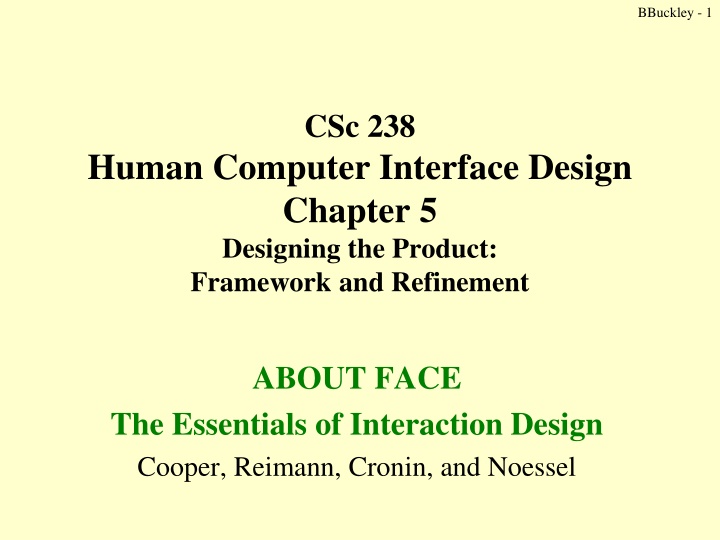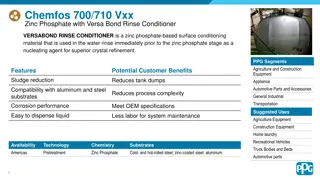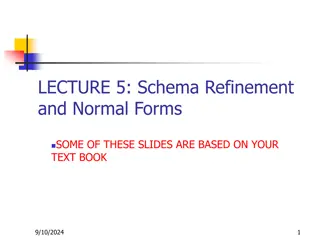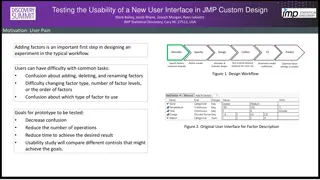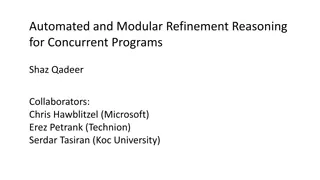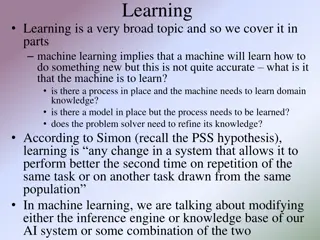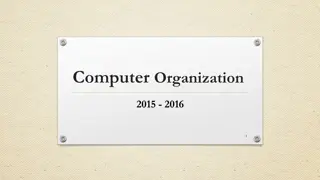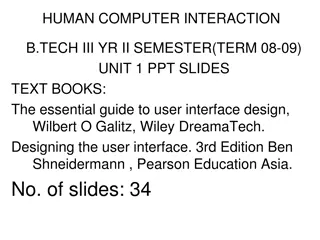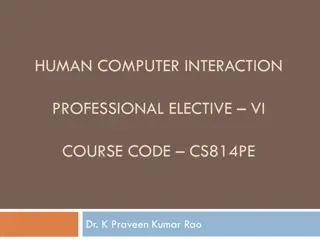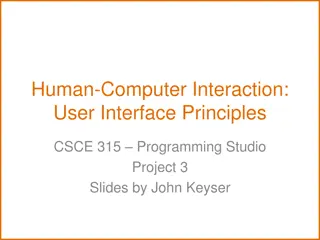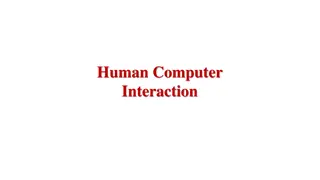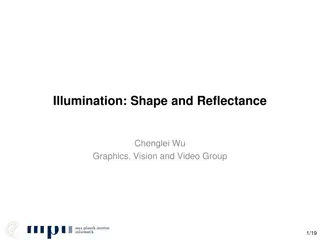Framework and Refinement in Human Computer Interface Design
This content delves into the requirements definition process for designing products with a focus on interaction design. It covers creating personas, identifying design requirements, and utilizing scenarios to extract needs and define fundamental interaction frameworks. The process involves defining form factors, postures, input methods, and functional elements to ultimately refine the product design. Design principles and key path scenarios are outlined to ensure validation and alignment with user interactions.
Download Presentation

Please find below an Image/Link to download the presentation.
The content on the website is provided AS IS for your information and personal use only. It may not be sold, licensed, or shared on other websites without obtaining consent from the author.If you encounter any issues during the download, it is possible that the publisher has removed the file from their server.
You are allowed to download the files provided on this website for personal or commercial use, subject to the condition that they are used lawfully. All files are the property of their respective owners.
The content on the website is provided AS IS for your information and personal use only. It may not be sold, licensed, or shared on other websites without obtaining consent from the author.
E N D
Presentation Transcript
BBuckley - 1 CSc 238 Human Computer Interface Design Chapter 5 Designing the Product: Framework and Refinement ABOUT FACE The Essentials of Interaction Design Cooper, Reimann, Cronin, and Noessel
2 Requirements Definition Process 1,2,3 Create Explore and Identify Persona Expectations Construct Context Scenarios Identify Design Req'ts Problem and Vison Statements Brainstorm Identify Design Requirements: Data Functional Contextual (relationships or dependencies between sets of objects in the system environment product will be used in when choosing items for purchase, a summed list of items already selected) Other requirements: Business Brand and experience, technical, customer and partner
3 Requirements Definition Process 1,2,3 Create Explore and Identify Persona Expectations Construct Context Scenarios Identify Design Req'ts Problem and Vison Statements Brainstorm Research to Design: Scenarios provide means of imagining ideal user interactions Use scenarios to extract design requirements (needs) Use these requirements to define the product s fundamental interaction framework Filling in that framework with ever-increasing amounts of design detail Define what the product will do before you design how the product wil do it. DESIGN PRINCIPLE
4 Fig. 5-1 The Framework Definition Process Define form factor, posture, and input methods 1. Define form factor, posture, and input methods 2. Define functional and data elements 3. Determine functional groups and hierarchy 4. Sketch the interaction framework 5. Construct key path scenarios 6. Check designs with validation scenarios Determine functional and data elements Determine functional groups and hierarchy Sketch the interaction framework Construct key path scenarios Check designs with validation scenarios
5 1. Define form factor, posture, and input methods Form Is it a web app to be viewed on HD computer screen? Is it a phone app (small, low-resolution, visible in bright light)? What are the constraints? Posture How much interacting will there be? What level of attention is needed to respond to users? Input Methods Related to form factor and posture Keyboard, mouse, keypad, thumb-board, touchscreen, voice, game controller, remote control, etc.
6 2. Define functional and data elements Data Objects (photos, email messages, customer records, etc.) Functional Operations on data elements and their representations in the interface Includes tools to act on and ways to visually and structurally manage data elements return to the context scenarios, persona goals, and mental models to ensure that our solutions are appropriate
7 Criteria for assessing possible design solutions Again, referring to context scenarios, persona goals, mental models Proposed solutions should: Accomplish user goals most efficiently Be a best fit for your design principles Fit within technology or cost parameters Possibly differentiate the interaction from the competition Other best fit requirements Pretend the product is human Apply principles and patterns Note: Scenarios provide an inherently top-down approach to IxD
8 Determine functional groups and hierarchy Given a good list of top-level functional and data elements Issues to consider: Which elements need a large amount of screen real estate, and which do not? Which elements are containers for other elements? How should containers be arranged to optimize flow? Which elements are used together, and which are not? In what sequence will a set of related elements be used? What data elements would be useful for the persona to know or reference at each decision? What interaction patterns and principles apply? How do the personas' mental models affect organization?
4. Sketch the Interaction Framework Framework sketches should be simple, starting with rectangles, names, and brief descriptions of relationships between functional areas. Details can be visually hinted at to give an idea of the contents, but don't fall into the trap of designing detail at this stage. Fig. 5-2 An early framework sketch from designs Cooper created for Cross Country TravCorps, an online portal for traveling nurses.
10 5. Construct Key Path scenarios Key Path the way in which the persona interacts with the product. Storyboarding Process variations and iteration Simulates user accomplishing their goals Not typically a simple linear process
11 6. Check designs with validation scenarios After you have storyboarded your key path scenarios and adjusted the interaction framework until the scenarios flow smoothly and you are confident shift to the less frequent or less important interactions Alternative scenarios Necessary-use (must be performed) scenarios Edge-case scenarios
12 Defining the visual design framework STEPS: 1. Develop experience attributes 2. Develop visual language studies 3. Apply the chosen visual style to the screen archetype Cooper process: Gather any existing brand guidelines. Familiarize yourself with them. If the company has clear brand guidelines built around one product-the product you re designing much of your work may have already been done for you. Gather together examples of strongly branded products, interfaces, objects, and services. Including multiple examples from particular domains will help stakeholders think about their differences. If we include images of cars, for instance, we might include examples from BMW, Toyota, Ferrari, and Tesla.
13 Develop experience attributes (Cooper) Work with stakeholders to identify direct and indirect competition. Gather examples of these products and services products and interfaces to include in your examples. Pull relevant terms mentioned by interviewees in the course of your qualitative research. Pay particular attention to any pain points mentioned. For instance, if many mention that a competitor or the existing version of the product is hard to use or "unintuitive," you may want to discuss whether "friendly," "easy," or "understandable" should be an attribute. With the brand guidelines, example products, competition, and user notes on display to reference, have a discussion with stakeholders about the sub brand of the product you're designing. We often ask stakeholders to vote for and against examples placing red or green stickers on them, and then discuss any clear winners, losers, or controversial examples.
14 Develop experience attributes (Cooper) From the outcomes of this discussion, identify the minimum number of adjectives that define and distinguish the product If any of the words have multiple meanings, document the exact sense intended. "Sharp," for instance, could refer to precision and sleekness, or it could mean intelligence and wit Consider competitors. If your set of attributes does not distinguish the brand from competitors, refine them until they do. Also make sure that individual attributes are aspirational. "Smart" is good. "Brilliant" is better Check back with the stakeholders (and especially any marketers) your proposed attribute set to discuss and finalize them before moving forward
15 Defining the visual design framework STEPS: 1. Develop experience attributes 2. Develop visual language studies 3. Apply the chosen visual style to the screen archetype Explore a variety of visual treatments through visual language studies. Within every picture is a hidden language that conveys a message, whether it is intended or not. This language is based on the ways people perceive and process visual information. By understanding visual language as the interface between a graphic and a viewer, designers and illustrators can learn to inform with accuracy and power
16 Defining the visual design framework STEPS: 1. Develop experience attributes 2. Develop visual language studies 3. Apply the chosen visual style to the screen archetype The final step is to apply one or two selected visual styles to key screens typically coordinate visual and interaction design efforts so that this step is performed close to the end of the interaction framework. At that point the design has begun to stabilize, and sufficient specific detail reflects the visual style. This further refines the visual style so that it reflects key behaviors and information. By making the design more concrete, you can better assess the feasibility of the proposed solution without the overhead of updating numerous screens for each minor change. Additionally, it's easier to elicit feedback from stakeholders.
17 Defining the industrial design framework Process: 1. Collaborate with interaction designers about form factor and input methods Develop rough prototypes Develop form language studies 2. 3. Step 1: There is only onen user experience: Form and behavior must be designed in concert Form and behavior must be designed in concert DESIGN PRINCIPLE There is only one user experience: The demands of interaction must guide the industrial design.
18 Defining the industrial design framework Process: 1. Collaborate with interaction designers about form factor and input methods Develop rough prototypes Develop form language studies 2. 3. Industrial designers sketch and create rough prototypes from foam board and other materials. often, shown to different stakeholders because each one has different cost and ergonomic considerations
19 Defining the industrial design framework Process: 1. Collaborate with interaction designers about form factor and input methods Develop rough prototypes Develop form language studies various looks applied to the specific form factors and input mechanisms. include shape, dimensionality, materials, colors and finish. informed by persona goals, attitudes, aptitudes, experience keywords, environmental factors, manufacturing and pricing constraints. requiring multiple iterations. 2. 3.
20 Defining the Service Design Framework Process: 1. Describe customer journeys 2. Create a service blueprint 3. Create experience prototypes A descriptive narrative describing the persona s use From 1stexposure to final transaction Each journey provides the designer the opportunity to identify secondary paths where the service helps the persona recover from a nuanced problem
21 Defining the service design framework Process: 1. Describe customer journeys 2. Create a service blueprint 3. Create experience prototypes The big picture Touch points where the persona uses the service Describes backstage processes that deliver a service Starting with the customer experience may help identify unexpected touch points in the service map
22 Defining the service design framework Process: 1. Describe customer journeys 2. Create a service blueprint 3. Create experience prototypes Service designers illustrate a persona s individual experience through the experience prototypes including mock-ups of key touch points
23 Refining the Form and Behavior the phase that translates the sketched storyboards into full-resolution screens depicting the user interface at the pixel level. The end product of the design process: Often a printable Form and Behaviorspecification Includes screen renderings detailed enough for developers to code The design team should continue to work closely with the construction team throughout implementation
24 Validating and testing the design putting the designed solution in front of users Helps in identifying problems with the Interaction Framework and/or the need for refinement Note the limitation for new products this process reflects feedback from 1st time users only! Usability tests determine how well a design allows users to accomplish their tasks and, with additional testing, feedback on how well the design helps users reach their end goals. Remember user s don t design Designers may need to go back to their drawing boards
25 What to test? Usability testing should be effective in validating: Naming Do section/button labels make sense? Do certain words resonate better than others? Organization Is information grouped into meaningful categories? Are items located in the places customers might look for them? First-time users and discoverability Are common items easy for new user to find? Are instructions clear? Are instructions necessary? Effectiveness Can customers efficiently complete specific tasks? Are they making missteps? Where? How often?
26 Testing be sure that what you are testing can actually be measured, that the test is administered correctly that the results will be useful in correcting design issues, and that the resources necessary to fix the problems observed in a usability study are available
27 Formative and Summative evaluations? In Formative evaluation, programs or projects are typically assessed during their development or early implementation to provide information about how best to revise and modify for improvement. This type of evaluation often is helpful for pilot projects and new programs, but can be used for progress monitoring of ongoing programs. In summative evaluation, programs or projects are assessed at the end of an operating cycle, and findings typically are used to help decide whether a program should be adopted, continued, or modified for improvement. manager).
28 When to test? Summative and Formative evaluations Summative: tests the value of completed products if you need to convince stakeholders or developers that the current product does have a usability problem, watching real users struggle through basic tasks is convincing. Formative: an iterative process of testing during design Provides feedback on the effectiveness of the design and an opportunity to make corrections allowing the designers to see how (and, with interviews, why) their target audience responds to the information and tools provided to help them accomplish their goals.
29 Formative Usability Tests: Advice Test late enough in the process so that there is a concrete design to test, and early enough to allow adjustments in the design &implementation. Test tasks & aspects of the user experience Use participants from the target population (personas as a guide) Ask participants to perform tasks while thinking aloud Have participants interact directly with a low-tech prototype (except when testing specialized hardware where a paper prototype can't reflect nuanced interactions) Moderate the sessions to identify issues and explore their causes Minimize bias by using a moderator who has not previously been involved in the project Focus on participant behaviors and their rationale Debrief observers after tests are conducted & identify the reasons behind observed issues. Involve designers throughout the study process
30 The need for Designer involvement in Usability Studies Designers should be the primary consumer of the findings Designers should be involved in: Planning the study to focus on important questions about the design Using personas and their attributes to define recruiting criteria Using scenarios to develop user tasks Observing the test sessions Collaboratively analyzing study findings
